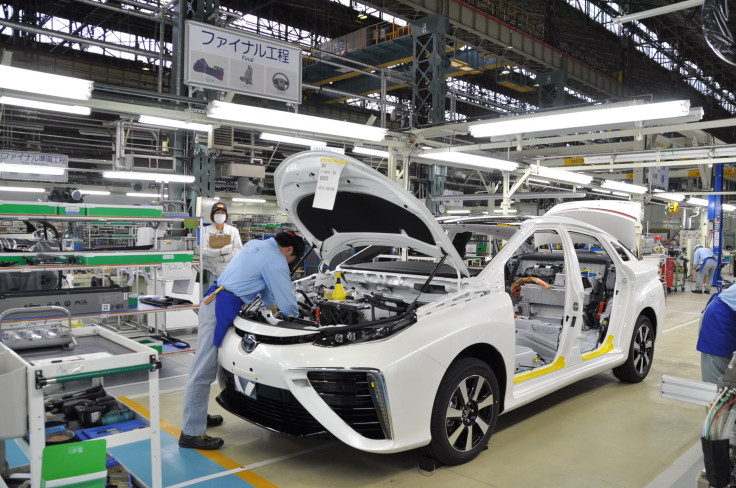Toyota Mirai Hydrogen Fuel Car Begins Production As Tesla Motors CEO Elon Musk Cringes

Toyota Motor Co. on Tuesday officially kicked off production and sale of the Mirai, the company’s hydrogen-powered four-door midsized sedan. Though its initial production targets are low, Toyota is cautiously emerging as the auto industry's biggest proponent of hydrogen-powered cars. But skeptics, including Telsa Motors CEO Elon Musk, say hydrogen has no future as a fuel source for consumer vehicles like the Mirai.
“Like the [Lexus] LFA of lore, the Mirai is hand built,” said Bertel Schmitt at the Daily Kanban blog, who attended the ceremony honoring the vehicle’s kick-off at Toyota’s Motomachi plant in Toyota City, Japan. “No assembly line, no robots. Just 13 workers assemble the Mirai, and only three cars are made each day.”
Described by plant assistant manager Mitsuyuki Suenaga as a “very inefficient process,” the production of the Mirai will move at a snail’s pace as workers learn how to assemble a hydrogen-fuel-cell car platform. Toyota says it aims to increase production of the car gradually in this training workshop from 700 vehicles this year to 4,000 by 2017.
Last month, Prime Minister Shinzo Abe was one of the first to receive a Mirai as he made bold proclamation about ushering in the “hydrogen era.” Japan is pushing the technology by reducing regulations, building fuel cell filing stations and offering subsidies of as much as $25,500 for the $61,000 vehicle. The car will go on sale in California sometime this year for $57,500, excluding the state’s fuel-cell incentive of $13,000.
Hydrogen fuel cells have been around for more than a century. They’re used in the International Space Station because they offer a reliable source of electrical power whose byproducts are simply electricity, heat and water, all things you could really use in space.
But hydrogen skeptics point out nobody has really yet figured out how to produce hydrogen from renewable resources on a commercial scale. Testing in labs have yielded viable hopes of a future zero-emission source for hydrogen, but for now the element is currently harvested using natural gas and coal, though a process of electrolysis that harvests hydrogen from water. The hydrogen is then mixed with oxygen in a fuel cell stack to produce electricity that powers a car’s electric drivetrain.
Electricity on the other hand is already being produced in some parts of the world where natural resources – namely a mix of geothermal, hydro-electric, wind, solar and nuclear – allow local grids to be powered partially or fully without fossil fuels.
One of the most vocal skeptics of hydrogen is Tesla Motors CEO Elon Musk. He’s made numerous (and sometimes colorful) comments in the past about the technology.
Speaking at the at the Automotive News World Congress in Detroit last month, Musk explained in detail why he thinks hydrogen has no future in cars:
“Electrolysis is extremely inefficient as an energy process . . . if you, say, took a solar panel and use the energy from that to just charge a battery pack directly, compared to try to split water, take the hydrogen, dump the oxygen, compress the hydrogen to an extremely high pressure (or liquefy it) and then put it in a car and run a fuel-cell, it is about half the efficiency, it’s terrible. Why would you do that? It makes no sense.”
Carter Driscoll, Tesla senior analyst of investment bank MLV & Co., said in a telephone interview after Tesla’s quarterly report earlier this month that it’s no surprise the man who wants to electrify the automotive industry would be a vocal critic of hydrogen.
“You would expect Musk to make these comments about hydrogen, considering he’s selling an electric car,” he said. “His mindset has always been getting away from fossil fuels. He sees putting charging infrastructure in your garage and putting an electric storage unit in your basement. He wants to change the way energy is collected and stored in this country.”
© Copyright IBTimes 2024. All rights reserved.




















